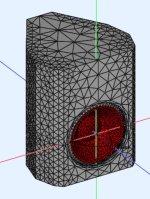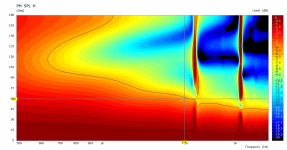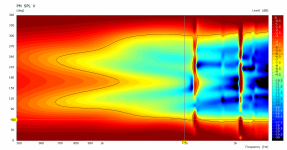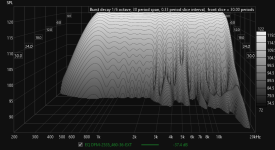that black cylindrical part in the photo. I thought about a centering jig but who knows.)
Ah, you're probably right, I guess. Then, what I wrote is rather meaningless.
Other drivers that I've noticed in this context:
Oberton D5073
https://oberton.com/en/products/ferrite-hf-drivers/221-d5073.html
Looks like that is an easily detachable throat adapter on top, then the question is how it looks like underneath.
Faital HF106
https://faitalpro.com/en/products/HF_Drivers/product_details/index.php?id=502010325
https://en.toutlehautparleur.com/diaphragm-faitalpro-hf106-hf107-8-ohm.html
The exit is part of the removable top cover, using a custom replacement a horn throat could start near the base of the conical part of the phase plug, probably.
You've mastered that pretty well.Here's a teardrop shaped enclosure.
You can decrease Mesh.LengthSegments to eliminate that large number of thin triangles around the woofer (shown below as how I would do it; Mesh.LengthSegments = 4). I also noticed that the "horn" is not connected to the enclosure - it should be. (Don't ask me how now, but I think you should connect the outer edge of the source to WG0 - it's defintely in the User Guide).
Attachments
Last edited:
My interest in the ESP plug got re-kindled after a person I know purchased a pair of Klipsch Jubilee (which uses Celestion Axi2050 with THE mysterious plug).
The Jubilees sound really good to be honest and are to be used for soul and disco parties.
Hopefully after Christmas I will be able to do polars and (hopefully) settle the klipsch plug argument.
The latest itteration of the ESP plug still has issues and this is how it measures on axis.
Blue Trace - Semi-OSSE horn (no plug)
Green Trace - Semi -OSSE horn with ESP plug (shifted 10db down)

And quick and dirty on axis vs. off axis vs. more off axis with 10db offsets
EQ'd "flat" on axis

And last graph with the traces with no offset and 1/6 Oct Smoothing
At this point I'm not sure if the ESP plug is screwing with the directivity or the horn itself is a bit off.

The Jubilees sound really good to be honest and are to be used for soul and disco parties.
Hopefully after Christmas I will be able to do polars and (hopefully) settle the klipsch plug argument.
The latest itteration of the ESP plug still has issues and this is how it measures on axis.
Blue Trace - Semi-OSSE horn (no plug)
Green Trace - Semi -OSSE horn with ESP plug (shifted 10db down)
And quick and dirty on axis vs. off axis vs. more off axis with 10db offsets
EQ'd "flat" on axis
And last graph with the traces with no offset and 1/6 Oct Smoothing
At this point I'm not sure if the ESP plug is screwing with the directivity or the horn itself is a bit off.
When I heard them at a hifi show in a big room trying to play some acoustical instrument song, they sounded shouty, unsophisticated and bulldozer like. Perhaps it is best at parties....The Jubilees sound really good to be honest and are to be used for soul and disco parties.
//
I don't have any at hand. But in general, a smooth frequency response corresponds to a clean decay. It's difficult to measure in limited spaces we typically use for indoor measurements. It's calculated from the same impulse response but for a waterfall to have any sensible resolution, you would need much longer reflection-free time (or an anechoic chamber)...
Last edited:
You can decrease Mesh.LengthSegments to eliminate that large number of thin triangles around the woofer (shown below as how I would do it; Mesh.LengthSegments = 4). I also noticed that the "horn" is not connected to the enclosure - it should be. (Don't ask me how now, but I think you should connect the outer edge of the source to WG0 - it's defintely in the User Guide).
Thanks for correcting me on WG0 and helping me with Mesh.LengthSegments, @mabat. In addition to the primary goal of OSSE/R-OSSE mathematics the other features of ATH such as Source.Contour and Box are amazing educational tools.
For @sheeple and everyone else, this is the line I forgot to include in the previous config file. New zip file attached.
; Waveguide start
point p25 -1 47 20 ;
line p25 WG0 0 ; start of ATH waveguide

Horizontal / Vertical


Attachments
I don't have any at hand. But in general, a smooth frequency response corresponds to a clean decay
This is the only waveguide waterfall measurement I can find, I don't know whats going on here but it would be nice to see 1m Measurement in REW of a large Waveguide on a nice compression driver. I want to see Something that represents some of the best of what waveguiding has to offer.
If anyone has outdoor measurements of waveguides please share them
This is the decay of one of the recent waveguides (with a throat extension):
https://www.diyaudio.com/community/...-design-the-easy-way-ath4.338806/post-7435961
It's important to understand that no matter what the device is, a high-pass response per se has its inherent decay as well. When measured in a full-range system, including a woofer and a crossover, it will be very different.
https://www.diyaudio.com/community/...-design-the-easy-way-ath4.338806/post-7435961
It's important to understand that no matter what the device is, a high-pass response per se has its inherent decay as well. When measured in a full-range system, including a woofer and a crossover, it will be very different.
Last edited:
I took the impulse response from the links that @mabat posted, gated it to aprrox. 4.86ms (due to reflections from surroundings coming in after that), equalized it to flat and created a burst decay plot.
Obviously, we have a reduction in the frequency resolution determined by that gate window but I think it is more useful than allowing all the reflections inside and wondering what caused what.
Comparsion of unequalized and equalized responses of the DFM 2535 on the horn

Burst decay showing 40dB of dynamic range on the y-axis

If someone wants anechoic quality waterfall measurements, some can be found at ASR (for some relatively smaller waveguides than the ones being discussed here). For example: https://www.audiosciencereview.com/...jbl-4349-review-studio-monitor-speaker.22686/
Obviously, we have a reduction in the frequency resolution determined by that gate window but I think it is more useful than allowing all the reflections inside and wondering what caused what.
Comparsion of unequalized and equalized responses of the DFM 2535 on the horn
Burst decay showing 40dB of dynamic range on the y-axis
If someone wants anechoic quality waterfall measurements, some can be found at ASR (for some relatively smaller waveguides than the ones being discussed here). For example: https://www.audiosciencereview.com/...jbl-4349-review-studio-monitor-speaker.22686/
Attachments
I'm working on an analysis of throat extension, it's interesting and quite promising. Some summary to be provided later.


It's funny how much there's still to learn, mostly discovered as a by-product of something else. Watch this -
An "ordinary" 1" throat:


Somewhat extended 1" throat


An "ordinary" 1" throat:
Somewhat extended 1" throat
shiiid if it could make 2 inchers appear to sound like 1.4s then that would be magic indeed.
"extension" is always there due to ferrite compression driver construction - 13 years ago it was "unwanted resonance" 😉
There's a lot more to it than "short/long". We should be perhaps talking about radiation patterns instead. If "short" means better controlled, as it typically is, I tend to agree.In horn a/b tests, a shorter horn always sounds better. More open.
- Home
- Loudspeakers
- Multi-Way
- Acoustic Horn Design – The Easy Way (Ath4)
